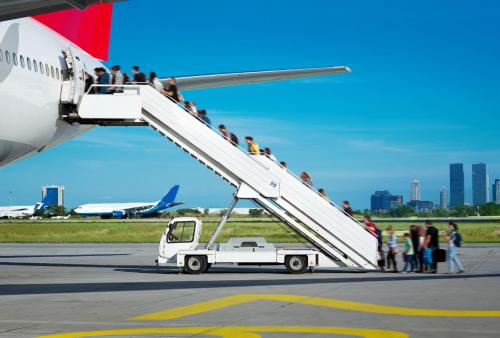Why You Always Board Planes on the Left

Every time you step onto a commercial airplane, you probably follow a familiar routine. You book your flight ticket, check your boarding pass, queue up in the designated line, and make your way towards the aircraft. But have you ever wondered why, almost without exception, you always board planes on the left side? This seemingly mundane aspect of air travel has a fascinating history and practical rationale. In this blog post, we'll explore the reasons behind this tradition and delve into the world of aviation to understand why you always board planes on the left.
1. Historical Roots: The Legacy of the Horse and Carriage
To uncover the origins of this practice, we need to travel back in time to the early days of aviation. When airplanes first entered the scene, they were not the only mode of transportation around. Horses and carriages were still widely used, and many airports were adapted from existing equestrian facilities.
Back then, passengers would board aircraft from various sides, depending on the layout of the airport and its proximity to other transportation methods. However, the convention of boarding on the left side can be traced back to the traditions of horse-drawn carriages. In many cultures, people would mount and dismount horses from the left side, known as the "near side." This preference was largely due to practical reasons: most people are right-handed, and mounting from the left provided better control and stability.
As airplanes began to replace horse-drawn carriages as a mode of transportation, this left-side boarding tradition carried over. Airports were designed to accommodate this practice, creating a sense of continuity for travelers.
2. Safety and Efficiency
Beyond its historical roots, left-side boarding has several practical advantages that contribute to the safety and efficiency of air travel:
a. Consistency and Training: Standardization is a crucial aspect of aviation safety. By consistently boarding on the left side, airlines ensure that flight crews and ground personnel receive uniform training. This uniformity reduces the likelihood of errors and misunderstandings, ultimately enhancing safety.
b. Separation of Functions: Airlines maintain a clear separation of functions during the boarding process. Passengers enter through the left side while catering and cargo loading typically occur on the right. This separation minimizes the chances of confusion or accidents.
c. Familiarity for Passengers: Most travelers are accustomed to left-side boarding, making the process smoother and more predictable. When people know what to expect, they are less likely to create bottlenecks or engage in risky behavior.
3. Compatibility with Jetways and Airports
Modern airports are designed with jetways or passenger boarding bridges that connect terminals to aircraft. These structures are typically positioned on the left side of the plane, aligning with the left-side boarding tradition. This design consistency simplifies the boarding process and ensures that passengers can seamlessly transition from the terminal to the aircraft.
Additionally, airport infrastructure, such as gate layouts and terminal facilities, is often tailored to accommodate left-side boarding. Changing this practice would require significant alterations to airport design, which would be costly and disruptive.
4. International Standards
Aviation is a global industry, and international standards play a crucial role in ensuring safety and efficiency. The International Air Transport Association (IATA) and the International Civil Aviation Organization (ICAO) have established guidelines and regulations that govern various aspects of air travel, including boarding procedures. Left-side boarding has become an internationally accepted standard, facilitating smoother operations and consistency worldwide.
5. Rare Exceptions
While left-side boarding is the norm, there are some exceptions. Smaller aircraft, such as regional jets and turboprops, may allow for boarding from both sides to expedite the process. Additionally, military aircraft may have unique boarding procedures based on their specific mission requirements. Still, these exceptions are relatively rare and are typically limited to specialized circumstances.
Conclusion: Tradition Meets Practicality
The practice of always boarding planes on the left may seem like a mere tradition, but it has deep-rooted historical significance and practical advantages. From its origins in the world of horse-drawn carriages to its role in modern aviation safety and efficiency, left-side boarding has stood the test of time.
As travelers, we may not give much thought to the side from which we board an aircraft. However, the consistency and standardization of left-side boarding contribute to the reliability and safety of air travel. It's a reminder that even seemingly small details in the world of aviation can have a significant impact on our journeys through the skies. So the next time you board a plane and take that familiar left turn down the aisle, you'll know that it's a tradition steeped in history and designed with your safety and comfort in mind.
Post Your Ad Here
Comments